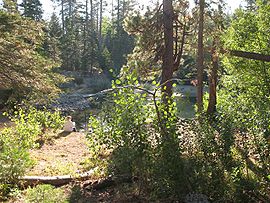
Lake Tahoe Basin Management Unit
Encyclopedia

California
California is a state located on the West Coast of the United States. It is by far the most populous U.S. state, and the third-largest by land area...
and Nevada
Nevada
Nevada is a state in the western, mountain west, and southwestern regions of the United States. With an area of and a population of about 2.7 million, it is the 7th-largest and 35th-most populous state. Over two-thirds of Nevada's people live in the Las Vegas metropolitan area, which contains its...
, encompassing approximately 191,000 acres (773 km²) of National Forest
United States National Forest
National Forest is a classification of federal lands in the United States.National Forests are largely forest and woodland areas owned by the federal government and managed by the United States Forest Service, part of the United States Department of Agriculture. Land management of these areas...
system lands, it ranges in altitude above sea level from 6,225 feet at lake level to 10,881 feet at Freel Peak, overlooking the City of South Lake Tahoe, California
South Lake Tahoe, California
South Lake Tahoe is the most populous city in El Dorado County, California, in the Sierra Nevada Mountains. The population was 21,403 at the 2010 census, down from 23,609 at the 2000 census...
.
The USDA Forest Service established the Lake Tahoe Basin Management Unit in 1973. The name of the Lake Tahoe Basin Management Unit reflects a unique sort of National Forest, as unique as the resources of the Tahoe Basin.
Goals
The Lake Tahoe Basin Management Unit (LTBMU) is responsible for the conservation, preservation and restoration of the Lake TahoeLake Tahoe
Lake Tahoe is a large freshwater lake in the Sierra Nevada of the United States. At a surface elevation of , it is located along the border between California and Nevada, west of Carson City. Lake Tahoe is the largest alpine lake in North America. Its depth is , making it the USA's second-deepest...
watershed
Drainage basin
A drainage basin is an extent or an area of land where surface water from rain and melting snow or ice converges to a single point, usually the exit of the basin, where the waters join another waterbody, such as a river, lake, reservoir, estuary, wetland, sea, or ocean...
ecosystem
Ecosystem
An ecosystem is a biological environment consisting of all the organisms living in a particular area, as well as all the nonliving , physical components of the environment with which the organisms interact, such as air, soil, water and sunlight....
within National Forest Lands. Projects and programs also include habitat, fire management, and urban lot management. Additionally the LTBMU provides and maintains high quality recreational opportunities for millions of visitors and residents annually.
Compared to other National Forest Lands the LTBMU is small, yet it is the Tahoe Basin's largest land manager, responsible for 78% of basin lands. As such the Forest Service has the largest single role in ecosystem and watershed management and protection. The LTBMU is a part of National Forest System Lands, yet is managed somewhat differently than other National Forests. Many common forest activities such as mining, grazing or timber harvesting are either not a part of LTBMU management or play a very small role. Since the lake is so dependent on all that happens around it, LTBMU programs manage the whole of the basin as a complete inter-dependent system.
The LTBMU is a unique inter-mix of forest and urban communities, presenting challenges and complexities few other National Forests experience. Since its establishment in 1973, the LTBMU has become a pioneer and leader in the science of forest and ecosystem management. The work of the Forest Service supports and is supported by many partners. Other federal, state and local agencies are working together in the effort to face challenges, conserve and restore natural and cultural resources, and enhance the recreational values of the Lake Tahoe Basin.
History
In 1899 when President William McKinleyWilliam McKinley
William McKinley, Jr. was the 25th President of the United States . He is best known for winning fiercely fought elections, while supporting the gold standard and high tariffs; he succeeded in forging a Republican coalition that for the most part dominated national politics until the 1930s...
created the Lake Tahoe Forest Reserve becoming the core of later National Forest Lands in the Tahoe Basin. Three separate forests were developed out of the reserve, the Tahoe, Eldorado and Toiyabe National Forests. Each of these forests extended into the basin and managed separate sections.
In 1973, the LTBMU was created from basin portions of the three existing National Forests, forming a single "management unit." This unification provided the focus needed for the basin, and more effective management of its watershed, ecological and recreational values. The name "Lake Tahoe Basin Management Unit" was originally a temporary one, but after three decades, the name remains.

